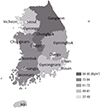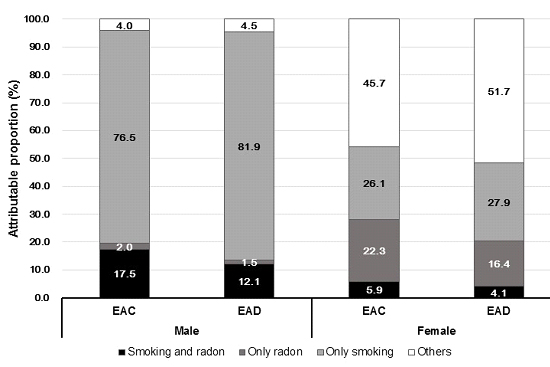3. International Agency for Research on Cancer. Man-made mineral fibers and radon. IARC Working Group on the Evaluation of Carcinogenic Risks of Humans. Vol. 43. Lyon: WHO Press;1988.
4. Kim Y, Chang BU, Park HM, Kim CK, Tokonami S. National radon survey in Korea. Radiat Prot Dosimetry. 2011; 146:6–10.
5. Catelinois O, Rogel A, Laurier D, Billon S, Hemon D, Verger P, Tirmarche M. Lung cancer attributable to indoor radon exposure in France: impact of the risk models and uncertainty analysis. Environ Health Perspect. 2006; 114:1361–1366.
6. Hänninen O, Knol AB, Jantunen M, Lim TA, Conrad A, Rappolder M, Carrer P, Fanetti AC, Kim R, Buekers J, et al. EBoDE Working Group. Environmental burden of disease in Europe: assessing nine risk factors in six countries. Environ Health Perspect. 2014; 122:439–446.
7. Peterson E, Aker A, Kim J, Li Y, Brand K, Copes R. Lung cancer risk from radon in Ontario, Canada: how many lung cancers can we prevent? Cancer Causes Control. 2013; 24:2013–2020.
8. Veloso B, Nogueira JR, Cardoso MF. Lung cancer and indoor radon exposure in the north of Portugal--an ecological study. Cancer Epidemiol. 2012; 36:e26–e32.
9. Committee on Health Risks of Exposure to Radon, Board on Radiation Effects Research, Commission on Life Sciences, National Research Council. Health Effects of Exposure to Radon. Washington, DC: National Academy Press;1999. (BEIR; 6).
10. Darby S, Hill D, Auvinen A, Barros-Dios JM, Baysson H, Bochicchio F, Deo H, Falk R, Forastiere F, Hakama M, et al. Radon in homes and risk of lung cancer: collaborative analysis of individual data from 13 European case-control studies. BMJ. 2005; 330:223.
11. Lim SS, Vos T, Flaxman AD, Danaei G, Shibuya K, Adair-Rohani H, Amann M, Anderson HR, Andrews KG, Aryee M, et al. A comparative risk assessment of burden of disease and injury attributable to 67 risk factors and risk factor clusters in 21 regions, 1990-2010: a systematic analysis for the Global Burden of Disease Study 2010. Lancet. 2012; 380:2224–2260.
12. Jee SH, Samet JM, Ohrr H, Kim JH, Kim IS. Smoking and cancer risk in Korean men and women. Cancer Causes Control. 2004; 15:341–348.
13. Murray CJ, Ezzati M, Lopez AD, Rodgers A, Vander Hoorn S. Comparative quantification of health risks conceptual framework and methodological issues. Popul Health Metr. 2003; 1:1.
14. United States Environmental Protection Agency. Assessment of risks from radon in homes. Washington, DC: United States Environmental Protection Agency;2003. accessed on 1 April 2014. Available at
http://www.epa.gov/radon/risk_assessment.html.
15. Turner MC, Krewski D, Chen Y, Pope CA 3rd, Gapstur S, Thun MJ. Radon and lung cancer in the American Cancer Society cohort. Cancer Epidemiol Biomarkers Prev. 2011; 20:438–448.
16. Menzler S, Piller G, Gruson M, Rosario AS, Wichmann HE, Kreienbrock L. Population attributable fraction for lung cancer due to residential radon in Switzerland and Germany. Health Phys. 2008; 95:179–189.
17. Chen J, Moir D, Whyte J. Canadian population risk of radon induced lung cancer: a re-assessment based on the recent cross-Canada radon survey. Radiat Prot Dosimetry. 2012; 152:9–13.
19. Turner MC, Krewski D, Chen Y, Pope CA 3rd, Gapstur SM, Thun MJ. Radon and COPD mortality in the American Cancer Society Cohort. Eur Respir J. 2012; 39:1113–1119.
20. Turner MC, Krewski D, Chen Y, Pope CA 3rd, Gapstur SM, Thun MJ. Radon and nonrespiratory mortality in the American Cancer Society cohort. Am J Epidemiol. 2012; 176:808–814.
21. Neri A, Stewart SL, Angell W. Radon control activities for lung cancer prevention in national comprehensive cancer control program plans, 2005-2011. Prev Chronic Dis. 2013; 10:E132.










 PDF
PDF ePub
ePub Citation
Citation Print
Print




 XML Download
XML Download